Find out what are the benefits of chicory for the body, what effect it has, its composition, how to properly prepare and take. Is it really useful or can be harmful to health.
The content of the article:
Chicory (options in English Cichorium, Сhicory or Succory) It is a medicinal plant that has been widely used for several centuries to treat various diseases. The greatest benefit is contained in the root part. For example, in ancient Rome, the root of the plant was used to improve the digestive process, in Egypt it was used as effective remedy against bites of poisonous snakes and spiders.
Today, chicory is widely used not only in folk medicine but also in cooking. It helps to significantly improve well-being, can be used in the fight against overweight, if there are no contraindications, it is allowed to take even during pregnancy as a substitute for harmful coffee.

Attention, just do not confuse it with Witloof - Belgian chicory, it is also called "salad", the photo shows that it grows like cabbage with a powerful root.
Chicory root contributes to the accelerated and gentle removal of dangerous toxins from the body, toxins accumulated over a long time, cleanses the blood of various harmful impurities. The root of the plant is used to prepare not only a popular, but also a healthy drink, which bears the uncomplicated name "Chicory".
The chemical composition of chicory and calorie content
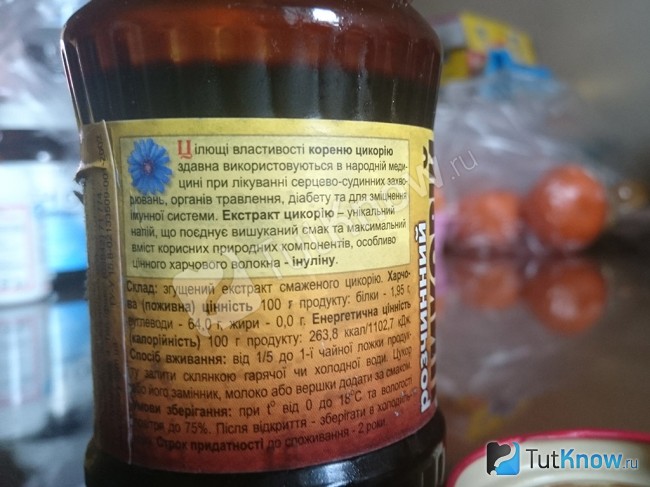
Chicory is one of the most useful medicinal plants for the body, but before taking it, it will be useful to familiarize yourself with the calorie content and composition.
Liquid calorie(thickened extract of fried chicory) per 100 g - 263.8 kcal (1102.7 kJ), as well as:
- Carbohydrates - 64.0 g
- Fats - 0.0 g
- Proteins - 1.95 g
- Carbohydrates - 56.0 g
- Fats - 0.0 g
- Proteins - 9.8 g
- Carbohydrates - 3.5─4.7 g
- Fats - 0.3 g
- Proteins - 1.7 g
- Fiber - 4.0 g
- Water - 92 g
- Sugar - 0.7 g
- A - 286 mcg
- E - 2.26 mg
- K - 297.6 mcg
- C - 24 mg
- B1 - 0.06 mg
- B2 - 0.1 mg
- B5 - 1.16 mg
- B6 - 0.11 mg
- B9 - 110 mcg
- PP - 0.5 mg
- B4 - 12.8 mg
- Potassium - 420 mg
- Calcium - 100 mg
- Magnesium - 30 mg
- Sodium - 45 mg
- Phosphorus - 47 mg
- Iron - 0.9 mg
- Manganese - 0.43 mg
- Copper - 0.3 mg
- Selenium - 03 mcg
- Zinc - 0.42 mg
The benefits of chicory for the human body
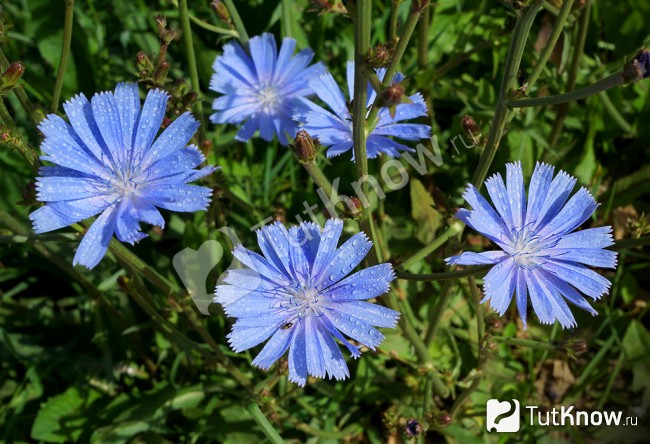
The composition of this medicinal plant includes a large number of nutrients that ensure vital activity and proper functioning. human body.
Action on the nervous system
Chicory contains a large amount of B vitamins, due to which the functioning of the nervous system is normalized. It gives a charge of vivacity, returns energy, helps to cheer up, while also acting as a sedative.
Action on the digestive system
This plant contains the polysaccharide inulin, which improves digestion, normalizes the intestinal microflora, prevents the development of dysbacteriosis, and helps to get rid of. Also, this substance will control blood sugar levels, so it helps to make you feel better when diagnosed. A properly prepared chicory drink can be consumed daily and is a great alternative to coffee.
Action on the cardiovascular system
Chicory contains a large amount of potassium. These substances are simply indispensable for the proper functioning of the heart, and also help to alleviate well-being in a variety of diseases associated with this organ.
A drink made from chicory helps to normalize the heartbeat, lowers the content of bad cholesterol and dilates blood vessels. Therefore, this plant is useful for patients with hypertension, in diagnosing coronary heart disease, tachycardia, etc.
Action on the immune system
Provided regular use in the food of chicory or a drink made from this plant, the beneficial substances that make up its composition help to strengthen immune system, resist a variety of infections, viruses and colds. There is an effective cleansing of the body of toxins and toxins, the metabolic process is being established. It is these qualities of chicory that have made it so popular among those who want to lose weight.
For skin diseases
It helps to get rid of a variety of skin diseases, because chicory has an excellent bactericidal and anti-inflammatory effect. are made with him alcohol tinctures and decoctions, added to the bath and can be used during the treatment of chicken pox, acne, eczema, vitiligo, diathesis, seborrhea, psoriasis, furunculosis, dermatitis and other skin diseases.
For diabetes and obesity
The composition of chicory contains a substance such as inulin, so it is simply indispensable for obesity, as it helps to speed up the metabolic process, and therefore helps in the fight against excess weight. But it does not cure diabetes!
For vision
To restore and improve eyesight, it is recommended to mix carrots with chicory juice, add a little parsley and celery. This tool has a positive effect on the muscular system of the eyes, prevents the onset of the development of various defects and pathologies.
During pregnancy
A chicory drink has a positive effect on the liver, improves and normalizes appetite, and prevents heartburn, which future mothers often suffer from. It helps to ease and improve the functioning of the intestines and heart, so the woman will feel great throughout pregnancy. However, such a drink can be taken only when the doctor allows, if there are no contraindications.
It is useful for pregnant women to drink milk, to which you can add a small amount of crushed chicory powder, it turns out not only tasty, but also a drink valuable for health. Thanks to the action of chicory, milk will be much better absorbed.
Scientists from Australia conducted a series of studies that showed that chicory increases the number of red blood cells, perfectly cleanses the blood, so the child will receive more nutrients and vitamins.
Useful properties of chicory
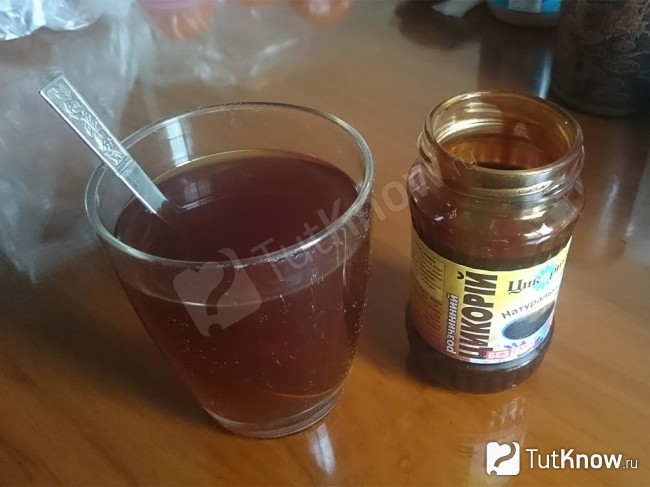
This plant helps with various ailments, while it can be taken orally or externally in the form of lotions and compresses:
- The plant helps to remove toxins from the body, therefore it has a positive effect on the functioning of the liver and helps with its various diseases.
- Chicory is used for gastritis, anemia, cholecystitis, enteritis, loss of strength, diseases of the spleen and constipation.
- Useful for diseases of cardio-vascular system, because it helps to improve the work of the heart. It is recommended for admission in the diagnosis of hypertension.
- It acts as a relaxing and sedative agent, therefore it is useful for neurosis or sleep problems.
- It can be used to prepare a decoction for lotions and added to the bath for skin infections, rashes, allergies.
- It has a choleretic and diuretic effect, therefore it is prescribed for cholelithiasis, cystitis, cirrhosis, hepatitis and nephritis.
- Therapists in India use chicory as an additive in toothpaste because it has an anti-inflammatory effect. Such a tool becomes simply irreplaceable in the development of periodontal disease.
Harm of chicory and contraindications
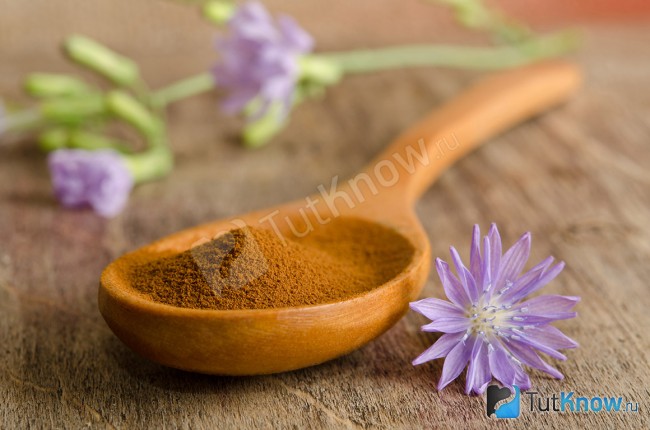
Like any other medicinal plant, chicory can cause harm to health, so its uncontrolled intake is strictly prohibited. There are some contraindications:
- Chicory can provoke a rather strong allergic reaction, so you should consult a doctor before taking it.
- The presence of individual intolerance to the plant and individual substances that make up its composition.
- The plant causes the expansion of blood vessels, therefore, it cannot be used in the presence of various vascular diseases, with development.
- Usually this drink does not lead to overexcitation, but in some people it can cause overexcitation and insomnia.
- You can not take chicory when diagnosing asthmatic bronchitis, a cough that has flowed into a chronic form, as well as diseases of the respiratory system, because the plant can increase the coughing fit.
- Do not abuse chicory and take it in unlimited quantities. This herb, when taken in excess, can cause performance problems. digestive system.
- Individual intolerance.
- Phlebeurysm.
- Chronical bronchitis.
- Asthma.
- Gastric ulcer.
Chicory for weight loss
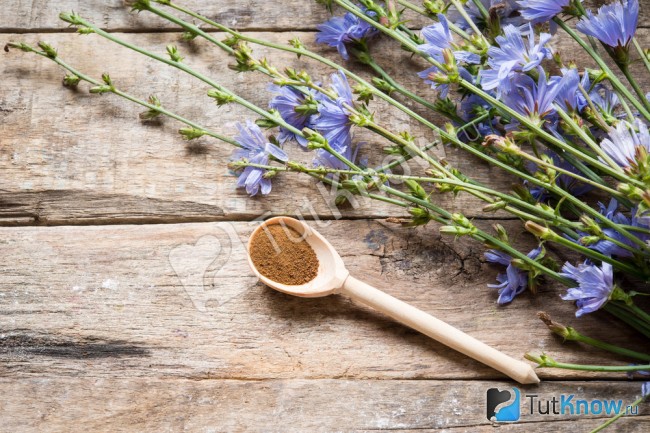
When losing weight, chicory plays an important role, because a decoction prepared from the root of the plant helps to speed up the metabolic process. As a result, your body processes the incoming food much easier and faster and does not allow fats to be deposited, turning them into energy.
A drink made from chicory is also recommended for obesity, because it contains such a valuable substance for the human body as inulin, helping to lower blood sugar levels. The lower they are, the less hunger is felt, overeating is prevented, and the figure gradually returns to its previous shape.
For weight loss, only the root of the plant can be used, if a decoction of its flowers is prepared by mistake, then hunger will only increase as a result, and you will get a completely opposite result.
Cook this healthy drink very easy - 1 tsp is poured into the coffee maker. chicory powder and pour 500 g of water. The mixture is brought to a boil, boiled for about 6 minutes. As soon as the drink has cooled, it must be filtered and taken 2-3 times a day for half a glass.
Nutritionists advise replacing coffee with instant chicory, which can be taken for several months. This remedy brings the greatest benefit in the case when it is drunk before the start of the meal.
What is chicory good for?
- Contains vitamins E, B1 and C, mineral salts, trace elements, inulin, pectin, chicorin, tannins.
- It has an antimicrobial and anti-inflammatory effect, normalizes appetite and digestion.
- Has a calming effect on nervous system, if added to coffee, is able to neutralize its harmful effects.
- Helps to remove toxins and radioactive substances from the body, speeds up metabolism, lowers blood sugar levels.
Types of chicory - which is more convenient for you to choose!
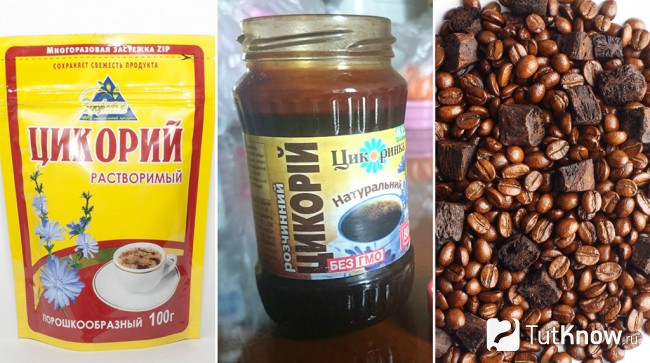
Depending on the type of chicory, its effect on the body will be determined:
- Soluble chicory (powdered) - dilates blood vessels, has a positive effect on the nervous and circulatory system, soothes. Prepare it as easy as instant coffee- dilute a teaspoon in 200-250 ml of boiling water.
- Liquid chicory - can be used in the treatment of diseases of the kidneys, liver, spleen. Preparation: for 200-250 ml of boiling water put one and a half or 1 tsp.
- In coffee (soluble mixtures) - when added to this drink, it eliminates its negative effect on the body.
- In tea - helps in the fight against excess weight, normalizes metabolism, has a beneficial effect on the functioning of the heart.
The benefits and harms of chicory have long been discussed by doctors and nutritionists. Before using it, it is important to remember that this is a medicinal plant, so it should not be abused and can be taken only after the permission of the doctor, if there are no contraindications. Chicory in small quantities is good for health and helps with various diseases.
Chicory- perennial herbaceous plant with a powerful fleshy spindle-shaped root. Its height is from 100 to 120 cm. The stem of the plant is straight, rough; leaves are short-petiolate, oblanceolate. Basal leaves form a rosette, stem leaves and leaves of cultivated plants are almost entire-marginal.
The flowers are large, bright blue, bloom from July to September. Large beautiful flower baskets sit at the ends of the branches and have a two-row wrap. The fruit is a seed.
The plant is found in the European part of Russia, in Ukraine, in Belarus, in the Caucasus, in the Crimea. Chicory grows in steppe ravines, along dry forests, in pine forests, along hillsides, on sandy and rocky screes.
The benefits of chicory known to people since ancient times, it is mentioned in the so-called Ebers Papyrus, an ancient Egyptian document containing medical information from the era of Pharaoh Amenhotep I (circa 1536 BC). According to this written source, the inhabitants of Ancient Egypt used chicory to prepare medicines for snake bites and poisonous insects.
The benefits of chicory were described in their writings by famous ancient doctors and scientists - Theophrastus, Dioscorides, Pliny the Elder. The healing characteristics of the plant interested Avicenna, who prepared preparations from it for the treatment of vision, joints, and digestive organs.
In the old days, chicory root was endowed not only with medicinal, but also magical properties. In many countries there was a belief that with its help you can become invisible. There was also such a sign: if on July 25 you dig up a chicory root and tie it to a staff, it will protect you from a knife and a bullet while traveling. The “Botanical Dictionary of Hermetic Medicine” by Paul Sedir says about this plant: “The root (chicory) can serve as a powerful remedy for spoilage, but it must be collected with appropriate ceremonies: on the birthday of John the Baptist, before sunrise, kneeling, touch root with gold and silver, and then with the sword of Judas Maccabee to pull out of the ground with oaths and other ceremonies. Being collected under Jupiter in Sagittarius or the Sun in Leo, and moreover in the hour of Venus, it acquires the properties to heal ulcers and wounds and contributes to the formation of scars.The popularity of chicory increased when, at the end of the 18th century, the German gardener Tamme from Thuringia first made a coffee substitute from the roots of the plant. Europeans fell in love new drink, although it was not cheap, because the raw materials were brought from afar. Until now, many peoples (for example, residents of Germany and the Baltic states) are happy to drink coffee with the addition of chicory. In Latvia, they cook from it cold drink with honey, apple juice and lemon, and in Estonia they love egg coffee with chicory.
No less successful medicinal plant and in our country. From 1889 until the beginning of the First World War, about 400 pounds of dry root were sent abroad from Russia annually. The main center of its procurement was the Yaroslavl province.
The chicory healer has not lost its significance even today. The beneficial properties of chicory are used in folk medicine, often added to medicines. The substances contained in it have antimicrobial, anti-inflammatory, sedative, urinary and choleretic effects. Chicory normalizes metabolism in the body, cardiac activity, acts as a vasodilator and antipyretic. It is used in the treatment of diabetes mellitus, diseases of the gastrointestinal tract, liver and kidneys.
The composition of chicory root contains a large amount of easily digestible substances, due to which it is the most valuable product nutrition, especially for people with diabetes. It is used in the preparation of sweets and cakes, added to coffee and tea drinks, which gives them unusual taste, smell and color. Chicory root powder, replacing coffee, strengthens the body and does not excite the nervous system. Since chicory coffee does not contain caffeine, there are practically no contraindications to its use. Chicory put in various dishes(salads, meat dishes, etc.), and are also used for baths prescribed for the treatment of obesity, diseases of the joints and skin.
To date, many cultivated varieties of chicory have appeared (leaf chicory witloof, endive, etc.). They are tasty, healthy, nutritious and contain a large amount of vitamin C. However, they medicinal properties, in comparison with the wild variety, are somewhat reduced, therefore, for medicines(decoctions, infusions, collections, baths) it is better to use common chicory. And dishes prepared from salad varieties can be used as an additional means of therapy. They are very effective in a diet designed for diabetics and obese people. Salads are made from shoots, leaves and stems of chicory. Young shoots are boiled and stewed. In Belgium, leaf chicory is baked with cheese or apples in wine. Witloof is very popular in many European countries, which is put in salads, soups and side dishes for baked, fried, stewed and steam fish. And in Italy they are very fond of radicchio chicory salad.
Chicory flowers contain chicory glycoside, which, when hydrolyzed, breaks down into esculetin and glucose. In milky juice there are bitter substances lactucin, lactucopicrin, taraxasterol, in fruits - protocatechin aldehyde.
Chicory roots are rich in water-soluble inulin (60%), a polysaccharide that is used in the diet of diabetics as a substitute for starch and sugar. These parts of the plant also contain the bitter glycoside intibin, which is widely used in the pharmaceutical industry. Sugars (up to 15%), bitter, resinous and tannins, organic acids, chicoryne, choline, proteins, fats, essential oil, vitamins A, C, B1, B2, PP, manganese, iron, potassium, sodium, phosphorus.
Inulin is also present in the leaves of the plant.
The range of therapeutic and beneficial effects of chicory is very wide. The plant removes toxins from the liver, stimulating its functions. Infusion of inflorescences calms the nervous system and improves heart function, it is prescribed for neurosis, insomnia, hypertension. A decoction of the root has a diuretic and choleretic effect, it is used for cystitis, cholelithiasis, nephritis, cirrhosis, hepatitis. A decoction of roots and herbs traditional medicine recommends for external use in eczema, acne, furunculosis, purulent wounds, diathesis, inflammation of the lymph glands (in the form of baths, lotions, poultices). Chicory is useful for general loss of strength, increased sweating, diseases of the spleen, it can be used as a means of normalizing blood composition. Since the time of Avicenna, decoctions and infusions of this plant have been prescribed for hyperacid gastritis, enteritis, colitis, cholecystitis, and chronic constipation. Fresh chicory juice helps treat scurvy and anemia.
In India, chicory is used in the manufacture of toothpastes that have an anti-inflammatory effect and prevent the formation of plaque.
Due to the hypoglycemic property, chicory decoction has an insulin-like effect, so it can be used to treat diabetes. The leaves of the plant, which are used to prepare salads in dietary nutrition, also have the ability to lower blood glucose levels. Instead of wild-growing chicory, you can use witloof, endive, escariole and other cultivars.
Chicory is used both individually - for monotherapy, and as part of medicinal preparations along with other plants. In 1993, a collection of medicinal herbs "Lydia" was patented in our country, intended for the treatment of diabetes. Together with other plants, it includes chicory roots. They are also included in the hypoglycemic collection patented in Croatia.
Chicory helps to normalize metabolism, which makes it effective in the treatment of obesity. Thanks to inulin, which promotes a feeling of fullness without consuming additional calories, the plant is widely used for weight loss.
V medicinal purposes use the root, grass and flowers of chicory.
Chicory root has astringent and hypoglycemic effects. Decoctions from it are used to treat diabetes mellitus, diseases of the gastrointestinal tract, liver and kidneys, as well as in case of diseases of the nervous system.
From herbs, plants prepare infusions and decoctions, which can also be used in the treatment of the above diseases. These funds are also used externally in the form of compresses, lotions, washes in the treatment of skin ailments.
Preparations prepared from wild chicory inflorescences calm the central nervous system, improve cardiac activity, increasing the amplitude and slowing down the heart rate.
Young shoots, stems, leaves of common chicory are recommended to be included in the diet.
Chicory in the treatment of diabetes
Diabetes mellitus has been known since ancient times; ancient doctors tried to treat people from this disease. But, despite the accumulated medical experience, it has not yet been possible to establish the exact cause of the onset of the disease.
Scientists believe that the hereditary factor can play the greatest role in the development of diabetes, especially if both parents of a person suffered from this disease. Those who have acute or chronic diseases of the pancreas are also predisposed to it.
There are known risk factors that contribute to the development of diabetes, even in those who are not genetically predisposed to it. These include infectious diseases, psychological trauma, constant nervous strain and stress, hypertension, atherosclerosis, as well as malnutrition: eating a large amount of foods rich in easily digestible carbohydrates, systematic overeating and obesity. Many of these factors are interrelated. Thus, stress and psychological trauma often lead to overeating, which is not far from obesity, which contributes to the development of type II diabetes.
Chicory roots are rich in fructose, which is beneficial food product for diabetics. Clinical studies have shown that inulin preparations made from the roots give a pronounced hypoglycemic effect in patients with non-insulin-dependent diabetes mellitus and, in addition, reduce daily fluctuations in blood glucose levels. Due to this, chicory inulin can be used as a treatment for patients with type II diabetes.
Chicory inulin is prescribed for monotherapy in newly diagnosed diabetes, in the case of a mild form of the disease and for the primary prevention of diabetes mellitus in people with reduced glucose tolerance and metabolic syndrome (impaired carbohydrate metabolism, hypertension, hyperproteinemia). In moderate and severe forms of the disease, inulin will help reduce the dose of the main hypoglycemic drugs and become excellent remedy prevention of complications of diabetes mellitus: diabetic angiopathy, peripheral neuropathy, retinopathy, nephropathies and encephalopathies.
In addition, inulin has positive influence on lipid metabolism, reduces the level of cholesterol and triglycerides in the blood, improves digestion. In addition, due to the satiety effect that inulin provides, you can reduce hunger without consuming additional calories, which is very important for diabetes and obesity.
Ways to use chicory in the treatment of diabetes
Decoctions, infusions, tinctures for internal and external use (baths, lotions, poultices, compresses) are prepared from the roots, herbs and flowers of chicory. Fees are widely used, the ingredients of which enhance the hypoglycemic effect of chicory, while showing their own beneficial properties.
Ginseng, Manchurian aralia, high lure, safflower-like leuzea, Chinese magnolia vine, Rhodiola rosea, and eleutherococcus senticosus help to normalize metabolism and restore hormonal balance.
Excess glucose is removed from the body by horsetail, knotweed, birch, lingonberries, which also have a diuretic property.
Common beans, common peas, blueberries and galega (goat's rue) preserve insulin from destruction, activate the synthesis of proteins and fats, delay gluconeogenesis and normalize the process of glucose uptake, facilitating its transportation into cells.
For the regeneration of beta cells in the pancreas, flax, walnut, burdock, licorice, blueberries, white and black mulberries are used.
The interaction of insulin with receptors will help normalize chromium-containing plants: mountain arnica, ginseng, medicinal ginger, noble laurel, penny lespedeza, gray alder, Siberian fir, marsh cinquefoil, medicinal sage, leuzea.
In addition to chicory, the group of inulin-containing medicinal herbs includes elecampane, dandelion officinalis and Jerusalem artichoke, which form fructose upon hydrolysis.
Very useful for diabetes are blueberries and oats, which regulate blood glucose levels. Decoctions of blueberry leaves and berries are used as an effective hypoglycemic agent.
decoction of chicory root
Ingredients: 1 teaspoon minced chicory root.
Mode of application
. Pour raw materials with 200 ml of boiling water, put on low heat and warm for 10 minutes from the moment of boiling, then strain and cool.
. Drink 50 ml 3 times a day diabetes.
. A decoction of chicory root is also used as cholagogue in diseases of the pancreas, gallbladder, liver (including gallstone disease); as a diuretic in kidney disease; to improve digestion and treat metabolic disorders. Externally, it is used for baths, lotions and compresses for skin diseases and gout.
Concentrated decoction of chicory root
Ingredients: 2 tablespoons minced chicory root.
Mode of application
. Pour raw materials with 200 ml of cold water and put on fire. After boiling, warm for 10 minutes, then strain.
. Drink like tea for diabetes.
Infusion of chicory root
Ingredients: 2 teaspoons minced chicory root.
Mode of application
. Pour raw materials with 200 ml of boiling water, let it brew for 1-2 hours, then strain.
. Drink infusion per day in 3-4 doses. Use a remedy for the treatment of diabetes.
Infusion of herbs and chicory root
Ingredients: 1 tablespoon crushed chicory flowering tops, 1 tablespoon crushed chicory root.
Mode of application
. Pour vegetable raw materials with 200 ml of boiling water, cover with a lid, wrap and let it brew for 1 hour, then strain.
. Take with diabetes 1 tablespoon 3 times a day before meals. The course is 10 days. Then you need to take a break of 7 days and repeat the treatment.
Infusion of chicory herb
Ingredients: 1 teaspoon chicory herb.
Mode of application
. Pour raw materials with 200 ml of boiling water, tightly close the lid, let it brew for 30 minutes, then strain.
. Drink with diabetes 100 ml 2-3 times a day before meals.
. Chicory herb infusion can be used to treat diseases of the gastrointestinal tract, liver, kidneys, as well as neurasthenia and hysteria.
Medicinal collection (recipe 1)
Ingredients: 4 tablespoons of common chicory leaves, 4 tablespoons of leaves walnut, 4 tablespoons of goat's rue herb, 4 tablespoons of nettle leaves, 4 tablespoons of dandelion leaves.
Mode of application
. Mix the ingredients, separate 2 tablespoons of the collection and pour 500 ml of boiling water. Bring to a boil and heat over low heat for 2-3 minutes, then let it brew for 30-40 minutes and strain.
. Drink 50 ml 3-4 times a day 15-20 minutes before meals with diabetes.
Medicinal collection (recipe 2)
Ingredients: 5 tablespoons of common chicory leaves, 5 tablespoons of wild strawberry leaves, 5 tablespoons of highlander herb, 5 tablespoons of medicinal dandelion.
Mode of application
. Mix the ingredients, separate 2 tablespoons of the collection and pour 500 ml of boiling water. Put on fire and boil for 3-5 minutes, then let it brew for 1-1.5 hours and strain.
. Drink 60-70 ml 2-3 times a day 20-30 minutes before meals with diabetes.
Medicinal collection (recipe 3)
Ingredients: 2 tablespoons of common chicory root, 2 tablespoons of licorice root, 2 tablespoons of five-lobed motherwort, 2 tablespoons of cinnamon rose hips, 2 tablespoons of blood red hawthorn, 3 tablespoons of burdock root, 3 tablespoons of centaury herb ordinary, 1 tablespoon herb kidney tea, 1 tablespoon peppermint herb, 1 tablespoon herb Veronica officinalis, 1 tablespoon black birch leaves.
Mode of application
. Mix all the ingredients, separate 2-3 tablespoons of the collection, pour into a thermos and pour 500 ml of boiling water. Let it brew overnight, strain in the morning.
. Take the infusion warm, 70 ml 3 times a day 30 minutes before meals in case of diabetes.
Medicinal collection (recipe 4)
Ingredients: 2 tablespoons of common chicory root, 2 tablespoons of burdock root, 2 tablespoons of common flax seeds, 7 tablespoons of blueberry leaves, 7 tablespoons of common bean pods.
Mode of application
. Mix all the ingredients, separate 2-3 tablespoons of the collection and pour 500 ml boiled water room temperature. Leave for 12 hours, then place on water bath and warm up for 15 minutes. Infuse for another 1 hour, then strain.
. Take 200 ml 3-4 times a day 30 minutes before meals in case of diabetes.
Medicinal collection (recipe 5)
Ingredients: 3 tablespoons of common chicory herb, 2 tablespoons of common raspberry leaves, 2 tablespoons of marsh cudweed herb, 1 tablespoon of St. John's wort herb.
Mode of application
. Mix all the ingredients, separate 2 tablespoons of the collection and pour 300 ml of boiling water, insist under the lid, wrapped in a towel for 2 hours, and then strain.
. Drink infusion during the day in small sips for diabetes.
Medicinal collection (recipe 6)
Ingredients: 3 tablespoons of common chicory herb, 3 tablespoons of cinnamon rose hips, 2 tablespoons of herb shepherd's bag, 2 tablespoons of common juniper fruit, 2 tablespoons of peppermint leaves, 1 tablespoon of goose cinquefoil herb.
Mode of application
. Mix all the ingredients, separate 2 tablespoons of the collection and pour 300 ml of boiling water. Wrap and let it brew for 2 hours, then strain.
. Take the resulting infusion for diabetes, drinking it during the day in small sips.
Medicinal collection (recipe 7)
Ingredients: 2 tablespoons of common chicory leaves, 2 tablespoons of lanceolate plantain leaves, 2 tablespoons of burdock root, 2 tablespoons of horsetail herb.
Mode of application
. Mix all the ingredients, separate 2 tablespoons of the collection and pour 500 ml of boiling water. Put on fire and warm for 10 minutes, then let it brew under the lid for 1 hour and strain.
. Take 4 times a day, 100 ml before meals in diabetes mellitus. The course of treatment is 30 days.
Chicory juice
Ingredients: 1 kg of young chicory stalks.
Mode of application
. Only shoots collected at the budding stage are suitable for making juice. When harvesting, you need to cut off the tops about 15-20 cm long.
. Rinse the raw materials thoroughly, pour over with boiling water and pass through a meat grinder. Squeeze the resulting slurry through a dense cloth, drain the juice into enamelware and put on fire. After boiling, heat for 1-2 minutes.
. Take with diabetes 3-4 times a day, 1 teaspoon, diluting this amount in 100 ml of milk. The course of treatment is 1-1.5 months.
. Chicory juice lowers blood sugar levels, in addition, it can be used for anemia as a means of calming the nervous system and toning the heart. Outwardly, it is used to treat boils, eczema, pustular skin diseases, diathesis in children.
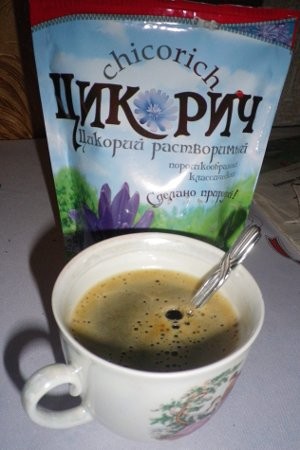 Soluble chicory
Soluble chicory
Benefit instant chicory large enough, as well as the benefits of many other plants used by humans to improve their health. Chicory helps to dilate blood vessels, is able to relieve attacks of tachycardia, has a beneficial effect on the nervous system and circulatory system, and soothes. It is also useful for all digestive organs. The benefits of chicory have long been recognized by the people, there are many folk recipes, which include chicory, it is appropriate in the treatment of diseases of the liver, kidneys and spleen. Chicory root (soluble chicory) is a unique product that can replace coffee in the morning, giving the human body exceptional vigor for the whole day. It should be noted that it is an excellent general tonic.
Contraindications
Serious contraindications to the use of chicory have not been identified. An exception is individual intolerance, although it is quite rare. Like many other plants, chicory can cause a skin reaction in people who are prone to allergies.
Since the plant promotes the expansion of blood vessels, it is not recommended for use in vascular diseases, varicose veins and hemorrhoids.
Although chicory is good for the gastrointestinal tract, overuse of it can cause digestive problems.
With extreme caution, chicory preparations should be taken by those who suffer from gastritis, stomach and duodenal ulcers, liver diseases, bronchitis, asthma, chronic cough and other diseases of the respiratory system. The fact is that taking such drugs can increase the cough.
Although chicory, unlike coffee, does not contain caffeine, it still acts as a stimulant, so people who are being treated for insomnia, stress, and depression should not use preparations from this plant in large quantities.
So there is almost no harm in chicory. Only individual contraindications are possible. If you have any doubts, then consult a specialist.
Chicory salad
We still underestimate this salad vegetable of winter and spring, which can be quickly grown at home, in a bucket. Chicory is a biennial plant. In the first year it forms a beet-like root, and in the second year blue flowers bloom on it. Chicory is valuable because it grows very quickly, it is harvested from December to March. Chicory sprouts contain about 10 mg of vitamin C e 100 g, carotene, phosphorus, calcium, magnesium and iron. Its dietary properties are very important at this time. In, it contains magnesium-containing substances (intybin), glycoside, cichorine, then choline, arginine and inulin. Chicory has a moderate diuretic effect, stimulates appetite and intestinal motility. It is well tolerated by diabetic patients. We started growing chicory again. It is sown in May, harvested in October. Roots with leaves cut at a height of 2-3 cm, with an undisturbed core, are folded in the basement (cellar) and accelerate growth at a temperature of about 15 °, not higher, and in the dark (under a black film). The roots are laid closely to each other, covered with earth and a 10-centimeter layer of sawdust or sand. The process takes about a month. Then cut off the shoots, which should be white. They will turn green in the light and taste bitter. Sprouts can be obtained from the root and hydroponically. At home, they should be put in a bucket and, covered with earth, left in the cellar. If necessary, they are brought to a warm room, accelerating growth in the dark. Salads are made from chicory, it is stewed, baked and fried in breadcrumbs. Chicory is used primarily in fresh but it can also be heat treated.
General information: A plant of the Asteraceae family, also called witloof, originated from the widespread root chicory. In culture, chicory has been known since the 19th century. It is grown in many European countries. Witloof is cultivated in a two-year culture: in the first year, long white conical roots and a rosette of dark green elongated leaves are obtained, in the second - a tall branched stem, flowers and seeds. In winter, cabbages with juicy white leaves are obtained from root crops.
Varieties
There are no domestic varieties of salad chicory yet, therefore foreign varieties are used.
For diet food with diabetes and obesity, you can use salad varieties of chicory, whose delicate and juicy greens also have a hypoglycemic effect.
The leaves and sprouts of chicory salads contain inulin and intibin (it is this that gives the plants a bitter taste). Inulin, which regulates the body's metabolism, is used as a sugar substitute. Intibin improves digestion, liver function, blood vessels. All this makes cultural types of chicory very useful for people suffering from diabetes.
Like chicory, chicory salads belong to the Compositae family. The states of Eurasia are considered the homeland of these plants and North Africa. In its own way nutritional value they are not inferior to the usual leaf lettuce. They contain great amount vitamins and microelements.
They grow well and give a large harvest not only in household plots, but also in a city apartment: on window sills, glazed balconies and loggias.
Cultivating wild chicory began in the 17th century in Holland, when its roots were specially grown to replace expensive coffee.
A little later, people tried the aerial parts of the plant, and since then leaf chicory has firmly entered national cuisines many European countries. Selected chicory salads differ appearance; they are united not only by a common ancestor, wild chicory, but also by a bitter taste, as well as the useful substances contained in them.
As salad varieties of chicory, endive and its varieties (escariole and frise, or curly endive), witloof, radicchie and radicchio are grown.
Endive and escarole (escarole)
Escariol and endive have the same properties and differ only in appearance. Biological features bring them closer to garden salad. These biennial plants belong to ancient cultures; in Western Europe they began to grow them back in the 16th century. However, there is evidence that even the ancient Greeks and Romans were familiar with endive. India is considered the birthplace of these types of lettuce chicory, from where they were brought to Egypt, and then to the Mediterranean states.
Currently, endive and escariole are very popular in many European countries, in the USA and Canada. In addition to inulin and intibin, they contain salts of potassium, calcium, iron, magnesium and phosphorus, vitamins C, B1, B2, PP, P and other substances necessary for the body. These plants are useful for everyone, but most of all they are needed by patients with diabetes.
Endive, one of the main types of lettuce chicory, looks like a large rosette with long basal leaves. Its more famous variety in our country, the Frize (curly endive), has many narrow wavy-curly leaves, light green at the edges and yellowish, tender and almost non-bitter in the center.
Escariole is also a type of endive (smooth endive). The plant has broad, rounded petiolate leaves with smooth, serrated or slightly wavy edges. Like endive, escarole is dark green and yellowish greenish.
The stem of both types of lettuce is straight, branched. In endive, the flowers are small, lilac in color, while in escariole, they are blue or pink. The latter is more cold-resistant and tolerates frosts down to -3 °C.
At the initial stage of development, only roots and leaves are formed in these types of chicory salad. The ground part is a rosette of 50 or more leaves. To reduce bitterness, endive and escariole are bleached: about 2 weeks before harvesting, they are tied with twine, the outer leaves are lifted up and light is blocked inside, due to which the middle of the lettuce heads become light and tender. The leaves can be eaten raw, seasoned with citrus juice to neutralize the bitterness. But most often these types of chicory are added to mixed green salads. They are also good in salads with fruit ingredients: pineapples, peaches and pears.
At present, self-bleaching varieties of endive have been bred by breeders.
You can also use unbleached endive and escarole leaves, but it is recommended to blanch them to remove excess bitterness. These salads can also be stewed and served as a side dish or put in soups at the very end of cooking.
Friese is most often used in mixed salads: it decorates the dish and gives it a piquancy thanks to its bitterness.
This type of chicory goes well with other leafy salads, as well as with garlic, thyme, arugula. Its bitter taste is suitable for fish, shrimp, meat, fried bacon, soft cheese and citrus.
Vinegar is used to dress salads from endive, frieze and escariole, lemon juice, vegetable oil. You can add some honey to them, goat cheese, garlic or red onion.
its nutritional and healing properties fresh endive and escarole can be stored in the refrigerator for 2-4 days.
Recipes for chicory leaf dishes to suit all tastes are provided in the following sections of this book.
Witloof
Witloof is a leafy variety of wild chicory, a perennial plant that is grown as a biennial.
In the first year of its development, it forms long white roots and a large rosette of elongated large-leaved leaves, in the second year it blooms and produces seeds. The stem of the plant is branched, reaching a height of 1.5 m, with numerous white or blue flowers. Seeds are small, ribbed, brown.
Witloof has been known as a salad culture since the beginning of the 19th century. For the first time, they began to cultivate it in Belgium, which is why the name "Belgian chicory" was assigned to the plant. Then witloof began to be grown in Holland, this country still holds the lead in the selection of its varieties.
Currently, this variety of lettuce chicory is cultivated in the Netherlands, Belgium, France and several other European countries.
Witloof is grown for cabbages. They are driven out in the winter in a dark room from root crops that have ripened in the summer (you can simply cover the pots or boxes with an opaque cloth). When distilling, the temperature regime is important: at a temperature of 15-17 ° C, the cabbages retain their natural bitterness, but at 8-10 ° C they become sweetish, with a slight, barely noticeable bitterness.
Witloof leaves are juicy and crispy. Heads of cabbage are eaten raw, stewed, fried or boiled. To prepare salads, they are cut lengthwise, across, or sorted into leaves. Salads can be dressed with sour cream, vegetable oil, mayonnaise or citrus juice, removing bitterness. It can be easily eliminated by rinsing witloof in lukewarm water for 15-20 minutes or blanching in boiling water for 1 minute. For this purpose, you can also soak sprouts in salted cold water about 2-3 hours. Bitterness, which is concentrated mainly in the dense bottom of the head, decreases during heat treatment.
Boiled, fried or stewed, witloof is served as a side dish for various dishes.
Cut fresh sprouts do not lose their nutritional and palatability within 3 weeks if stored in a cool place.
Radicchio
Radicchio (radicchio) - purple-violet chicory leaf lettuce with large white streaks. Italy is the birthplace of radicchio. To achieve this color, it must be grown using a special technology. First, the heads of cabbage are allowed to harden, then they are closed from sunlight and slightly frozen. As a result, not the usual green chlorophyll accumulates in the leaves, but a purple pigment, which is an effective antioxidant that slows down the aging of the body.
The composition of radicchio contains the same beneficial substances as in other types of chicory. Its healing properties were admired by the Roman scientist and philosopher Pliny the Elder, who glorified this salad in his work Natural History. Radicchio is useful for diabetes, poor digestion and reduced immunity.
The taste of radicchio is bitter, spicy and very sharp, so it is usually added to dishes in a small amount. Winter varieties This type of chicory is less bitter than summer ones. Radicchio is used for mixed salads and assorted in combination with other vegetables. Bitterness can be removed by heat treatment.
In Italy, radicchio leaves are fried in olive oil, used in risotto and pizza, grilled, fried, stewed and served as a side dish. Together with other vegetables, they are put in soups. Leaflets torn into pieces are used to decorate and spice up dishes, whole leaves are used as portioned "salad bowls".
To reduce bitterness, dishes with radicchio are seasoned fruit juices, raspberry and balsamic vinegar, olive oil, honey, mayonnaise-based sauces. Stew this type of chicory in red wine or olive oil, tearing the leaves with your hands or cutting them into thin strips. Radicchio goes well with onions, garlic, thyme, arugula, capers, feta and parmesan.
You can store this type of chicory for 2 weeks in a cool place.
Radicchier
Chicory salad radicchie (radicchio, radicchio) is often confused with radicchio. Unlike the latter, radicchie has almost no leaves, but is grown for its juicy stem, painted in various shades of red (from very light to maroon).
The plant contains inulin and intibin, a large amount of vitamins (ascorbic, folic acid, carotene), minerals and trace elements (calcium, iron, magnesium, phosphorus, potassium). Radicchie juice contains the glycoside lactucin, which has a beneficial effect on the nervous system and has a slight hypnotic effect. The combination of potassium and sodium salts in lettuce is good for the liver, kidneys, pancreas and cardiovascular system. Radikchie is recommended to be included in therapeutic and dietary nutrition for diabetes mellitus, atherosclerosis, and obesity. By adding this type of chicory to food, you can adjust the disturbed water-salt metabolism in the body.
In Italy, where radicchie is called the "winter flower Italian cuisine”, it is grown in the north of the country.
Each region cultivates its own subspecies, which differ in both color and taste. Italians smear salad stalks with a mixture olive oil, balsamic vinegar, salt and pepper and roast it on the grill or in a frying pan. Then the dish is served as a side dish for fish or meat.
Radicchie is added to mixes of vegetables (including leaf lettuce), fruits, fish, seafood. It is used to prepare risotto, pasta (macaroni), poultry dishes. It gives the dishes a unique taste and piquancy.
Requirements: very cold-resistant, root crops do not freeze even at -30 ° C. It grows best on loamy and sandy soils, moderately seasoned with organic matter, with a reaction close to neutral. Responsive to the introduction of potassium, with a lack of an element in spring sowing plants, premature bolting begins. Chicory salad does not tolerate waterlogging.
Growing: cultivation techniques are the same as for beets and other root crops. Best timing sowing in the middle lane - May 20-28. The rows are made at a distance of 30 cm, with ribbons - 20 cm, the distance between the ribbons is 50 cm. The sowing depth is 0.5-1 cm. 3.5-4 g of seeds are required per 10 m 2.
For forcing lettuce chicory in winter greenhouses, root crops are leveled in height, cutting off the lower ends and leaving a length of about 22-23 cm. Plant root crops close, sprinkle with good soil and water abundantly in 2-3 doses. Forcing in the dark is most common, for which boxes with root crops are covered with peat or sawdust on top with a layer of up to 23-25 cm. The temperature is maintained at 12-15 ° C.
Care: chicory crops are thinned out twice at a distance of 10-12 cm, while obtaining root crops necessary for forcing heads of cabbage with a diameter of 4-5 cm. Fertilizing with weak solutions of ammonium nitrate - 5-6 g / m 2, potassium salt - 7-8 g / m 2 .
Winter germination of lettuce chicory
1. At the end of October, chicory should be carefully dug out of the ground with a pitchfork.
2. Place the dug up plants in a place protected from the sun in the open air and let them dry.
3. To prepare the chicory for germination, use a garden knife or pruner to carefully trim the leaves 3-5 cm above the root.
4. Pour a little earth at the bottom of the bucket, firmly install dried and cut roots into it, sprinkling them with soil mixture on top.
5. Germinate chicory in the dark, so the bucket must be covered. Watering is carried out only from below - from the pallet under the bucket.
6. After 35-40 days, shoots are formed on the roots, which, when they reach a length of 15 cm, can be broken off and used for food
Harvesting: root crops are harvested in late September - early October. Their leaves are cut 2-2.5 cm above the head. Store them in the same way as carrots or parsley.
Usage: heads of cabbage are used for food, they are cooked from them various salads, used for stewing, boiling. Chicory salad has valuable dietary properties and specific taste, stimulates appetite, improves digestion and heart function.
Many people use flavored drink which tastes like coffee. Such lovers, of course, want to know how soluble chicory is useful for the body.
Soluble mixture is a great help for those who suffer from hypertension and stomach diseases, but are not used to doing without a cup of coffee in the morning. Patients with these diagnoses decide not to take caffeine and choose chicory as an alternative.
In the old days, 20% of chicory roots were mixed with coffee beans and brewed in a coffee maker. Such a recipe will help to make a gradual transition from one drink to another.
Chicory is a herbaceous plant
In order to consider the beneficial properties of soluble chicory, it would be good to get acquainted with the raw materials from which it is made. Chicory ordinary is a perennial tall plant, with pale blue flowers. It is not rich in leaves, but blooms very profusely and is considered an excellent honey plant.
Of greatest interest is the root. In its shape, it resembles a spindle; it is from it that a valuable drink is obtained. The rationale is that it is large and beefy.
Valuable grass grows everywhere. It can be found on desert hillocks and along the road. Mass cultivation of chicory in the fields is also practiced in order to obtain the roots of this plant.
Useful properties of chicory root
What soluble chicory is useful for is the vital biological substances contained in the roots of the plant from which it is obtained. They include vitamins PP, B2, A, C, as well as useful elements such as manganese, phosphorus, potassium, sodium and iron. Due to the abundance of such components, the drink is used as a general tonic.
Chicory root also stores other nutrients: choline, pectin, lactucin, sugar, intibin, organic acids, protein compounds, ascorbic acid and tannins,
The earthy part of the plant is enriched with milky liquid and has a bitter taste. Therefore, a similar aftertaste is also present in powdered chicory soluble. Is the product from it useful for sick people?
Since ancient times, the root has been used to increase appetite and improve digestion. In folk medicine, it is used to normalize metabolism, in diseases of the liver, stomach, intestines and colds. Chicory root has anti-inflammatory, antibacterial and slightly laxative effects.
Some studies have shown that the lower part of the plant can have a sedative and astringent effect.
The presence of inulin in chicory roots is of great importance. This substance is contained in them from 60 to 80%, depending on where the grass grows. In particular, because of this element, chicory has found its use in medicine.
It should be clarified whether beneficial properties for the body are preserved in soluble chicory in the same composition as in the roots of the plant itself. To do this, you need to consider the process of manufacturing the mixture.

How is instant chicory obtained?
Chicory powder is obtained by grinding and drying the roots. It is replete with useful properties and is more used for medical purposes.
The technology of preparation of soluble chicory consists of several stages. The root mixture of the plant is exposed to high temperatures. The harm and benefit of the drink will depend on what kind of processing it has experienced.
Sublimated chicory is prepared by a new method. It is obtained by thickening extraction and spray drying. In a similar way, you can make a powdered mass at home. The cut and roasted root is passed through a coffee machine.
Which chicory is more useful
Which drink will be better depends to a greater extent on what goal the person is pursuing. For people with hypertension and some heart conditions, an instant fried drink may be more suitable. This will satisfy their emotional needs, as they would not like to part with coffee drinks. If a person wants to improve the functioning of his digestive system, then the usual powder from the roots will serve him as a medicine.
Unroasted powdered chicory is the most useful product made from the roots of the plant. It contains all useful substances. But for people who need a coffee substitute, it won't work as it doesn't have the desired flavor.
Liquid chicory count budget option. It has a longer shelf life, so it can be bought in large containers at a bargain price.
Soluble chicory, whose beneficial properties are slightly less, has an amazing aroma and excellent taste.
Sublimated chicory has recently appeared on store shelves. In this instant drink, all useful elements and vitamins are maximally preserved, as it was subject to low temperature conditions. It has a lighter color.
It is worth noting that the darker the powder, the less useful properties it has.
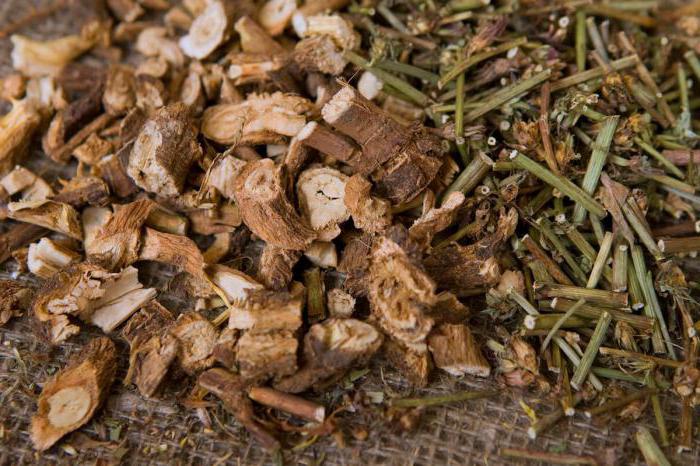
How to choose the right instant chicory
To protect yourself from low-quality products, you need the following actions:
- Buy the product only in sealed packaging, preferably in a vacuum.
- Pay attention to composition. The benefit will only be if real chicory root is present, and not its extract. Many manufacturers add flavorings and other chemical impurities in an attempt to disguise low-quality products. Sometimes, in order to save money, chicory is diluted with some natural powdered ingredients. But after that, the drink no longer bears its value.
- Carefully consider the soluble mixture. It should not have lumps. Qualitative mass, as a rule, is homogeneous and dry.
- The naturalness of the product can be checked by dissolving it in a spoon warm water. Chicory has its own specific smell, which would be good to remember. The sensation of richness in taste is an indicator natural product. There is a slight sweetness in the bitter drink.
How to check the product for quality
Many manufacturers manage to add crushed and toasted cereal grains to chicory. To determine the quality of the powdered mass, you can conduct an experiment:
- Pour water into two glasses.
- Pour a spoonful of natural chicory into one, into the other a mixture with the addition of grains.
- Add a few drops of iodine to each of them.
In a glass of natural chicory, iodine does not stain. Where there are cereal additives, it acquires a blue-violet hue.

What is useful chicory soluble for the body
For a person with good health, chicory will be an excellent preventive and restorative remedy. If everything is in order in the body, then the drink will not cause any side effects. Thanks to a large number vitamins soluble mixture gives protection against infections because it strengthens the immune system. Its use also has a positive effect on the condition of hair and skin. What is useful chicory soluble for medicinal purposes?
- The presence of iron in the product is a big plus for those who need to increase hemoglobin.
- Thiamine, located in the root of the plant, supports the work of blood vessels and the heart.
- Chicory contributes to normal blood sugar levels due to its inulin content. Hydrolysis converts chicory into fructose and sucrose. People suffering from early forms of diabetes are advised to use it regularly. It does not rise glycemic index. Chicory has a sweet aftertaste, which makes some people refuse to add sugar to the drink.
- Pectin (soluble fiber) is able to dissolve sugar in the blood. It is just like inulin, useful for diabetics.
- Cleanses the body of toxic substances.
- Promotes the proper functioning of the digestive system. Inulin is necessary for the normalization of the intestinal microflora. It feeds the important bacteria living in it. Metabolic processes in the human body occur correctly due to the presence of inulin.
- Doctors believe that the instant drink is aimed at the elderly, for the reason that caffeine is contraindicated for them.
From the above facts, we can conclude that soluble chicory is beneficial for the human body. Rather than rush to buy a vitamin complex, you can simply add this aromatic drink to your diet.
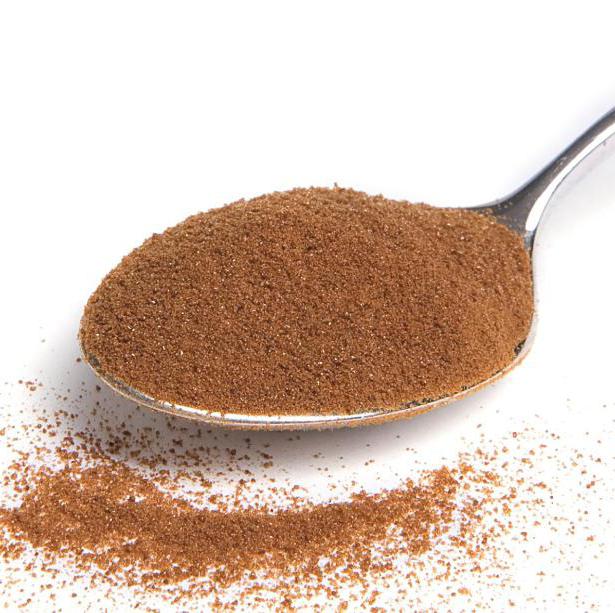
Benefits for the female body
How soluble chicory is useful for a woman's body will be shown by the following statements:
- As a rule, the fair sex tends to accumulate more fat cells than men. Chicory produces a cleansing effect, due to which the breakdown of fats occurs. The drink reduces the feeling of hunger, and this, in turn, prevents cellulite.
- What girl wouldn't want to have beautiful skin? It has been proven that folic acid has a beneficial effect on the epidermis. Just chicory root is rich in such a substance.
- For expectant mothers, a pleasant drink will provide invaluable support. It will relieve heartburn and alleviate the symptoms of toxicosis. The fact that chicory normalizes the formation of blood cells will benefit not only the pregnant woman, but also the unborn child.
What is useful chicory soluble for men
Is the drink suitable for the strong half of humanity? According to its qualities, soluble chicory is also good for men. The beneficial properties of the drink are especially important for the elderly. Age-related changes entail a number of urological problems. The drink will serve as an addition to the main treatment of such diseases. To prevent it, you need to use it for a long time.
The abundance of trace elements and vitamins has a positive effect on potency, as it produces a restorative effect. The constant use of chicory tones and supports the male body as a whole and is a great alternative for gourmets who do not want to give up the taste of coffee.
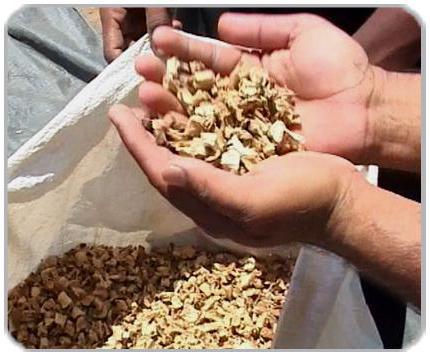
Contraindications
Although the beneficial properties and contraindications of instant chicory are determined by the process of preparing the product, there are still significant reasons to refuse it.
- Soluble chicory is noted as a vasodilator. It is contraindicated in diseases such as varicose veins and hemorrhoids, as well as in vascular pathology.
- With exacerbation of the digestive system.
- Diseases of the gallbladder and liver.
- It is worth giving up the drink during stress and insomnia, as well as if the patient is taking sedatives.
- It is not recommended to drink a healing instant drink more than 2 times a day.
- Asthma and chronic bronchitis.
An insufficient amount of vitamins in the body is dangerous to health. But an overabundance of the most useful substance can also cause enormous harm. It would be good for everyone to know what substances are missing in his body. It is important to periodically do examinations, and then make up your diet. The use of any natural product needs a measure. If there are any diseases, then before buying chicory, you need to consult a doctor.
And yet, what outweighs in soluble chicory - useful properties or contraindications. Reviews of some people will help to draw an objective conclusion.
Chicory is a well-known product, but an infrequent guest on our table. Chicory is a plant with oblong leaves, which has a long, dense root that goes deep into the ground. On sale, most often we find crushed dry chicory root, which is brewed as a drink, as an analogue of coffee, or as an addition to it. To complete the taste of a chicory drink, the benefits and harms are fully taken into account, the root is roasted. The leaves are less sought after, but can also be found on store shelves in the greens section, and are used in salads.
Chicory can be called a dual product, because its use can affect the body both beneficially and with negative consequences. In this article, we will talk about the benefits and harms of chicory, what useful properties this product has, what categories of people can include chicory in food, and consider the benefits and harms of soluble chicory - how to make a drink from chicory and how it is useful.
Useful properties of chicory, its composition and use in food.
1. Although chicory is considered a "weedy" plant, this is completely undeserved - it is just a storehouse useful substances and vitamins. So, chicory contains inulin polysaccharide (9-11%), which in Food Industry used as a sweetener. For diabetics, a chicory drink is a real salvation. It's sweetened naturally and does not increase blood glucose levels. The benefits and harms of soluble chicory are immediately revealed - of course, chicory has much more advantages than contraindications, which we will discuss below.
2. A high content of protein substances in chicory will give the body vigor and strength, a good boost of energy. A great addition to any sportsman's or traveler's snack.
3. Chicory contains the following vitamins:
- thiamine (provides normal functioning work of the heart, digestive and nervous systems);
- riboflavin or vitamin B2 (necessary for human reproductive function, maintains healthy nails, hair, skin, and even plays important role in the work of the thyroid gland);
- ascorbic acid (stimulating the body's immune system, strengthening blood vessels, maintaining normal muscle tone);
- carotene (a powerful antioxidant, prevents skin aging and a decrease in its elasticity, also has an immunomodulatory effect).
 4. Chicory juice strengthens and nourishes the muscular system of the eyes. But since it is rather difficult to obtain chicory juice even in the amount of one glass, it is allowed to mix it with other fresh vegetable juices, for example, carrot juice. Remember that in the juice, in which there are several components, for better absorption by the body, you need to add a couple of tablespoons of cream, milk or any vegetable oil (for example, sunflower oil) in the amount of 1 tsp.
4. Chicory juice strengthens and nourishes the muscular system of the eyes. But since it is rather difficult to obtain chicory juice even in the amount of one glass, it is allowed to mix it with other fresh vegetable juices, for example, carrot juice. Remember that in the juice, in which there are several components, for better absorption by the body, you need to add a couple of tablespoons of cream, milk or any vegetable oil (for example, sunflower oil) in the amount of 1 tsp.
5. Chicory increases appetite well, so it is recommended for people with impaired stomach function, with a lack of weight, or simply with a weak appetite. It is enough to drink chicory coffee before meals, the benefits and harms of which are described in our article, or add chicory leaves or seeds to your favorite dish.
Speaking about chicory, the benefits and harms here are simply obvious: doctors often prescribe chicory to pregnant and lactating women to restore strength and vitality. Since coffee is contraindicated during pregnancy and lactation due to caffeine, a drink made from chicory powder brightens up the daily diet and helps diversify the diet of young and expectant mothers.
Preparation of a drink from chicory.
Fortunately, ready-made soluble chicory powders are commercially available. You can buy chicory with numerous additives. The brewing principle is the same as for instant coffee. A couple of teaspoons of soluble chicory pour 150-200 ml of hot water, mix. You can add milk and cream to taste. Do not overdo it with sugar - the drink is sweetened by the chicory itself. By drinking coffee from chicory, the benefits and harms are compensated by the pleasure and the very note in the taste of the drink that you will love.

If you want to make a drink from chicory yourself, you will need several roots of this plant - 5-6 pieces. They need to be thoroughly washed and cleaned. Then the chicory roots must be dried. This can be done in an oven at 100 degrees Celsius for 4-6 hours with the door ajar. On a baking sheet before this, it is advisable to lay parchment or foil. If you have the opportunity to dry the roots on fresh air in the sun, it the best option. It will take more time - up to a whole week, but the result will please you. Dried roots must be cut into small plates. Fry them in a dry frying pan until brown. And then grind the resulting “raw materials” in a coffee grinder, using a blender, or with a hand mill, as you wish. Store tightly closed jar in a dark place. The shelf life of home-cooked ground chicory is no more than six months.
How to choose instant chicory, tips for consumers.
You can buy ready-made soluble chicory root powder in almost any supermarket in the tea / coffee department. It is also widely distributed in pharmacies and specialized phyto-oriented stores.
V glass jar the product looks great. V tin cans there is a danger of acquiring chicory ground into "dust" - in this case it is difficult to understand whether the manufacturer has diluted the chicory powder with something cheaper.
Chicory powder must be absolutely uniform, dry. There should not be any lumps, balls - their presence indicates that the product was not stored correctly, most likely in conditions of high humidity.
It is very convenient to use chicory in small “sticks”, bags in which a portion has already been measured. In this form, chicory is convenient to take on trips, to work, anywhere - poured the contents of the stick into a mug, poured hot water and enjoy the excellent taste of the miraculous drink.
Contraindications to the use of a drink from chicory.
Unfortunately, not all chicory is equally useful. For some categories of people with chronic diseases or disturbed functions of the body, it can do a disservice. instant drink from chicory can not be used for the following diseases:
- bronchitis;
- vascular disease;
- phlebeurysm;
- violation of the work of the heart, heart muscle;
- violation of the gallbladder.
 If you notice that after drinking chicory your heart rate has increased, you feel weak, dizzy or nauseous - consult a doctor and exclude this drink from your diet, perhaps you have contraindications to its use. Speaking about the benefits and harms of a chicory drink, it is impossible to draw an unambiguous conclusion. But I want to note that there are practically no cases negative impact drink from chicory on the human body. All arguments about the benefits and harms of chicory come down to one thing - chicory is useful to everyone. So drink to your health and have fun!
If you notice that after drinking chicory your heart rate has increased, you feel weak, dizzy or nauseous - consult a doctor and exclude this drink from your diet, perhaps you have contraindications to its use. Speaking about the benefits and harms of a chicory drink, it is impossible to draw an unambiguous conclusion. But I want to note that there are practically no cases negative impact drink from chicory on the human body. All arguments about the benefits and harms of chicory come down to one thing - chicory is useful to everyone. So drink to your health and have fun!
Chicory is a genus of biennial and perennial herbs belonging to the Asteraceae or Compositae family. With this name, many people imagine a plant with bright blue inflorescences, which can now and then be found growing as a weed in wastelands, meadows and roadsides. And that's right.
Chicory is a wonderful rich honey plant, as well as a favorite treat for livestock among pasture herbs. At the same time, most often you can find such a flower in Altai and Western Siberia. But, it grows well in such countries as Indonesia, the USA, India, Ukraine.
For the first time, chicory in Russia began to be grown in the Yaroslavl province in 1880, where two of its types are quite successfully cultivated today: ordinary chicory and salad chicory.
The rhizome of chicory, sometimes reaching fifteen to twenty meters in length, has great benefit for both women and men. In addition, in addition to medicine, it is widely used in the coffee industry, confectionery production, as well as home cosmetology. The specially processed root is used in conjunction with coffee beans to make a variety of coffee drinks and coffee substitutes. Roasted and properly dried chicory roots, included in coffee drink, are able to enrich the taste of grains, opening them taste palette. Fresh leaves of cultivated chicory, according to gourmets and restaurateurs, are a wonderful addition to spring vitamin salads and independent garnish for fish and meat dishes.
The chemical composition of chicory
The chemical composition of chicory root is rich in valuable trace elements and vitamins useful for the human body! It contains:
- tannins and protein substances,
- organic acids;
- carotene;
- iron;
- magnesium;
- potassium;
- sodium;
- calcium;
- B vitamins;
- vitamin C;
- pectin, etc.
Also, soluble chicory is rich in inulin (up to 60-80%), thanks to which its use can improve metabolic processes and normalize the digestive system, which will not only improve your health, but also give you wasp waist without exercise equipment and diets.
In addition, the inclusion of this popular drink in the diet puts the intestinal microflora in order, because inulin is the food of the necessary bacteria that live in the human intestine and are called bifidumbacteria. It should also be noted that neither tea nor coffee contains inulin. 
At the same time, it is difficult to describe the benefits and harms of instant chicory without mentioning that although the roasted and properly prepared root has a great resemblance in taste and aroma to coffee beans, it completely lacks caffeine, which is inherent in the two most popular morning drinks. And this means that chicory drink can be consumed by people suffering from some common ailments. So caffeine is able to increase vascular tone, and therefore it is forbidden for people with hypertension to take. It is also contraindicated in people who suffer from diseases of the cardiovascular system, because caffeine often causes heart rhythm failure.
An important property of soluble chicory is that it has a sweet taste and does not need the addition of granulated sugar, which, according to Canadian scientists, is added to coffee and tea by more than 80% of people. Eating too much sugar leads to extra pounds. Inulin is a polymer of fructose and does not increase blood sugar, and this, in turn, means that chicory, like spelt, is useful for people who are overweight and have diabetes.
Useful properties of soluble chicory

The benefits of soluble chicory are very great, as are the benefits of most other medicinal plants that a person has been using for centuries to improve the health of his body! Chicory root calms the nervous system, relieves tachycardia attacks, and also helps to dilate blood vessels. It is incredibly useful for the digestive tract. The benefits of chicory root are noted daily in positive feedback hundreds of people. There are many recipes for its preparation for the treatment of ailments of the spleen, kidneys and liver.
Chicory soluble is unique product, which is able to replace your morning coffee, charging the body and soul with energy and vivacity for the whole next day. It is worth recalling that such a drink is considered one of the most effective general tonic that will help to cope with attacks of diseases in the cold season.
Fresh chicory root juice mixed with fresh juice parsley, carrots or celery, actively acts on the eye muscles, supplying them with the necessary substances! 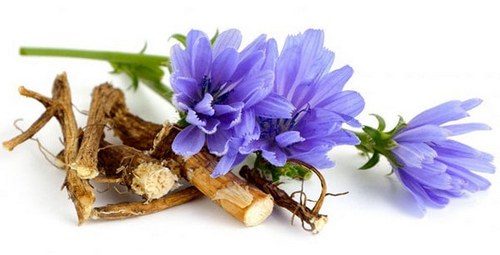
Many people note no less benefit of chicory added to medications. But medicines prepared on the basis of the root have anti-inflammatory, antimicrobial and choleretic properties. Chicory also normalizes appetite and helps to quickly get rid of the high temperature caused by infectious diseases.
Do not forget that the tincture of chicory flowers and roots is also used externally. Soluble chicory tea, the benefits and harms of which we are considering, helps to accelerate the healing of wounds, as well as eczema, psoriasis, furunculosis, dermatitis, etc. The quick effect of the infusion is due to its drying and anti-inflammatory effect.
Quite widely used chicory in cooking cosmetics. Rinses and shampoos, including given ingredient, improve the structure of the hair and promote their growth.
Read more information about the benefits of chicory, as well as about simple ways You can watch the video below to see how it works:
Chicory for pregnant women
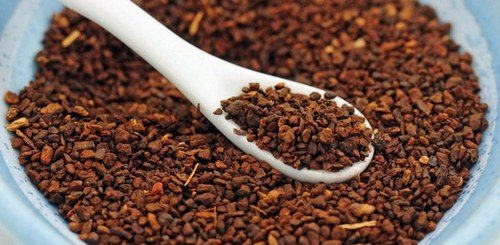
Love coffee, but worry about the health of the unborn child - it does not matter. Chicory is not only not harmful, but also useful for pregnant women. This nondescript plant will successfully replace coffee for you, as well as charge you and your baby with strength and health. The root will restore the heart rhythm, remove toxins, supporting the liver, which is incredibly important when carrying a child. In addition, chicory normalizes the digestive tract, relieving constipation and disorders. Also, the healing properties of chicory can relieve heartburn. And in order to completely forget about it, we recommend that you read about the benefits and harms of couscous.
Contraindications and harm of chicory
Starting a paragraph about the dangers of chicory, first of all I want to list contraindications, because Negative consequences can only be seen in certain people. People who suffer from varicose veins, asthma, vascular disease, and bronchitis should limit the use of this drink. Also, it is not recommended to drink a drink from chicory root for those who have a chronic cough. In these cases, chicory can be hazardous to health.
The benefits and harms of soluble chicory, as a rule, border on each other.
You will be surprised how such a useful product as chicory can harm the body. But, in some cases it can actually happen. Basically, the harm of chicory is associated with one component that the root is rich in, and this, if not strange, is ascorbic acid or vitamin C. 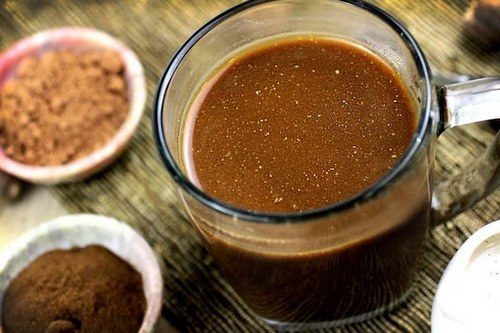
It is this vitamin that can cause unpleasant consequences in those whose body has a predisposition to allergic reactions. Even if you add to your culinary masterpieces minimum doses of this product, the chances of allergies due to vitamin C are huge.
Science has proven that hypervitaminization is just as dangerous for humans as beriberi. Therefore, before using chicory, be sure to consult your doctor.
Remember that you can not use the root in unlimited quantities, since the benefits of chicory for the body will be minimal compared to the damage caused to it.
Choosing the right chicory instant
At a time when it was quite difficult to get chicory root in stores in our country, the rhizomes were collected and processed at the house of the hostess. The roots extracted from the ground were dried, hung on the balcony, after which they were cut, fried and ground in a coffee grinder.
Today, such problems have receded before connoisseurs of instant chicory, and finished powder can be bought in every supermarket. As a rule, there you can find it in the departments of diet food. However, quite often chicory can also be found on pharmacy shelves. It is sold both in powder and root.
When choosing chicory, make sure the powder is dry and free of lumps. In turn, the chicory roots should be dry with a brown tint.
Storage of instant chicory

Stay Healthy and Beautiful with the site "I'm Healthy"!
After watching this video, you can learn even more about the benefits and harms of soluble chicory for the body:


